Speed limit
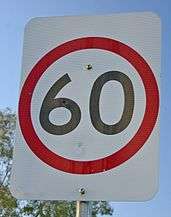
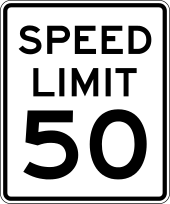
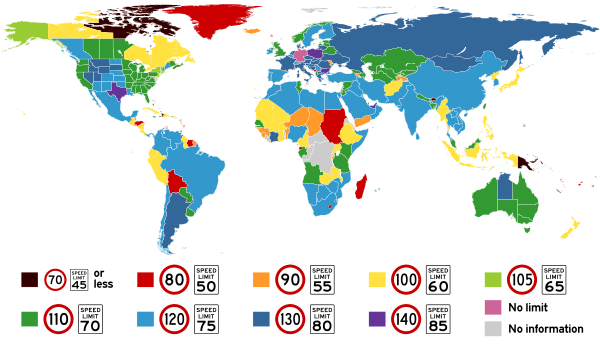
Road speed limits are used in most countries to set the maximum (or minimum in some cases) speed at which road vehicles may legally travel on particular stretches of road. Speed limits may be variable and in some places speeds are unlimited (e.g., on the Autobahn in Germany). Speed limits are normally indicated on a traffic sign. Speed limits are commonly set by the legislative bodies of nations or provincial governments and enforced by national or regional police and/or judicial bodies.
The first maximum speed limit was the 10 mph (16 km/h) limit introduced in the United Kingdom in 1861. The highest posted speed limit in the world is 140 km/h (87 mph), which applies to some roads in Poland[1] and Bulgaria;[2] similarly Texas posts 85 mph (137 km/h) on one 40-mile (64 km) long toll road.[3] However, some roads have no speed limit for certain classes of vehicles. Best known are Germany's less congested Autobahns,[4] where automobile drivers have no mandated maximum speed. Measurements from the German state of Brandenburg in 2006 showed average speeds of 142 km/h (88 mph) on a 6-lane section of autobahn in free-flowing conditions.[5] Rural roads on the Isle of Man[6] and the Indian states of Andhra Pradesh,[7] Maharashtra,[8] and Telangana,[9] also lack speed limits.
Speed limits are usually set to attempt to cap road traffic speed; there are several reasons for wanting to do this. It is often done with an intention to improve road traffic safety and reduce the number of road traffic casualties from traffic collisions. In their World report on road traffic injury prevention report, the World Health Organization (WHO) identify speed control as one of various interventions likely to contribute to a reduction in road casualties. (The WHO estimated that some 1.2 million people were killed and 50 million injured on the roads around the world in 2004.)[n 1] Speed limits may also be set in an attempt to reduce the environmental impact of road traffic (vehicle noise, vibration, emissions) and to satisfy local community wishes for streets usable by people out of cars. Some cities have reduced limits to as little as 30 km/h (19 mph) for both safety and efficiency reasons.[10]
In situations where the natural road speed is considered too high by governments, notably on urban areas where speed limits below 50 km/h (31 mph) are used then traffic calming is often also used. For some classes of vehicle, speed limiters may be mandated to enforce compliance.
Since their introduction, speed limits have been opposed by some motoring advocacy groups.
History
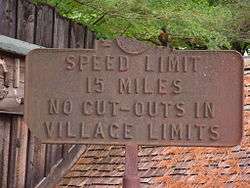
The United Kingdom Stage Carriage Act 1832 first introduced the offense of endangering the safety of a passenger or person by 'furious driving'.[11] The first numeric speed limits were created in the UK by a series of Locomotive Acts (1861, 1865 and 1878); the 1861 Act introduced a UK speed limit of 10 mph (16 km/h) on open roads in town, reduced to 2 mph (3 km/h) in towns and 4 mph (6 km/h) in rural areas by the 1865 'red flag act'. The Locomotives on Highways Act 1896, which raised the speed limit to 14 mph (23 km/h) (being the estimated speed of a horse being driven 'furiously') is celebrated to this day by the annual London to Brighton Veteran Car Run.
The first person to be convicted of speeding is believed to be Walter Arnold of East Peckham, Kent, who on 28 January 1896 was fined for speeding at 8 mph (13 km/h). He was fined 1 shilling plus costs.[12][13][14]
In Australia, during the early 20th century, there were people reported for "furious driving" offences. One conviction in 1905 cited furiously driving 20 mph (32 km/h) when passing a tram traveling at half that speed.[15]
Regulations
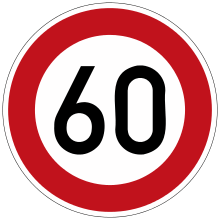
Most jurisdictions use the metric speed unit of kilometers per hour for speed limits, while some, primarily the United States and the United Kingdom, use speed limits given in miles per hour. Australia followed the United Kingdom system before changing to the metric system in the 1970s.
Basic rule
See also main article on the Basic Speed Law or Rule.
Reasonable speed
Drivers are required to drive at a safe speed for conditions. In the United States, this requirement is referred to as the basic rule,[16] but more generally in Britain and elsewhere in common law as the reasonable man requirement.[17] The German Highway Code (Straßenverkehrs-Ordnung) section on speed begins with a statement[18] which may be rendered in English:
Any person driving a vehicle may only drive so fast that the car is under control. Speeds must be adapted to the road, traffic, visibility and weather conditions as well as the personal skills and characteristics of the vehicle and load.
The US federal government has a similar law—49 CFR 392.14[19]—which applies in all states as permitted under by the commerce clause and due process clause.;[20][21] for example California Vehicle Code section 22350 which states that "No person shall drive a vehicle upon a highway at a speed greater than is reasonable ... and in no event at a speed which endangers the safety of persons or property".[22]
The basic speed law is almost always supplemented by specific maximum or minimum limits, but applies regardless. The reasonable speed may be different than the posted speed limit in conditions such as fog, heavy rain, ice, snow, gravel,[23] sharp corners, blinding glare,[24] darkness, crossing traffic,[25] or when there is an obstructed view of orthogonal traffic—such as by road curvature, parked cars, vegetation, or snow banks—thus limiting the Assured Clear Distance Ahead (ACDA).[26][27] Basic speed laws are statutized reinforcements of the centuries-old common law negligence doctrine as specifically applied to vehicular speed.[28]
Excessive speed
Consequential results of basic law violations are often categorized as excessive speed crashes; for example, the leading cause of crashes on German autobahns in 2012 was that category: 6,587 so-called "speed related" crashes claimed the lives of 179 people, which represented almost half (46.3%) of 387 autobahn fatalities in 2012.[29] However, "excessive speed" does not necessarily mean that the speed limit has been exceeded (if one even exists), rather that police determined at least one party traveled too fast for existing road[30] or weather[31] conditions.[29] Examples of conditions[32] where drivers may find themselves driving too fast include: wet roadways (rain, snow, or ice), reduced visibility (fog[33] or "white out" snow[34]), uneven roads, construction zones,[35] curves,[36] intersections, gravel roads,[37] and heavy traffic. Per distance traveled, consequences of inappropriate speed are more frequent on lower speed, lower quality roads;[38] in the United States, for example, the "speeding fatality rate for local roads is three times that for Interstates"[39]
Citations for violations of the basic speed law without a crash[40] have sometimes been ruled unfairly vague or arbitrary, hence a violation the due process of law, at least in the State of Montana.[41] Even within states, differing jurisdictions (counties and cities) choose to prosecute similar cases with differing approaches.[42]
Maximum speed limits
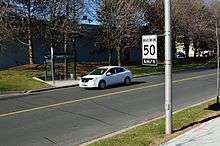
Most public roads in most countries have a legally assigned numerical maximum speed limit which applies on all roads unless otherwise stated; lower speed limits are often shown on a sign at the start of the restricted section, although the presence of streetlights or the physical arrangement of the road may sometimes also be used instead. A posted speed limit may only apply to that road or to all roads beyond the sign that defines them depending on local laws. In the European Union, large signposts showing the national (default) speed limits of the respective country are usually erected immediately after border crossings, with a repeater sign some 200 to 500 m (660 to 1,640 ft) after the first sign. Some places provide an additional "speed zone ahead" ahead of the restriction and speed limit reminder signs may appear at regular intervals which may be painted on the road surface.
Signs are normally placed on both sides of the road and in some places there are small (less than 1/4 the size of the sign) rectangular orange reflector flags attached to both upper right corners of both signs. The speed limit sign marking the new speed zone may also have the orange flags; this practice can be observed in New York on highways where the speed limit varies such as New York State Route 17.

Signage in many countries, especially in Europe, conforms to the Vienna Convention on Road Signs and Signals using black text with a red circle on a white background.
In the United States, the signs are usually rectangular with the words "SPEED LIMIT" and the values in black on a white background. The U.S. Federal Highway Administration's Manual on Uniform Traffic Control Devices provides guidelines for the appearance of speed limit signs. In Alaska and California, speed limits are often labeled "MAXIMUM SPEED" instead. In Oregon, most speed limit signs just say "SPEED" and the number. Canada has similar signs bearing the legend "MAXIMUM" and in km/h instead of mph. "Maximum" is used instead of "Speed Limit" because it has similar meanings in English and French. Australian signs are rectangular but have a red circle like the Vienna Convention signs.[43]
The speed limit is commonly set at or below the 85th percentile operating speed (being the speed which no more than 15% of traffic is exceeding)[44][45][46] and in the US is typically set 8 to 12 mph (13 to 19 km/h) below that speed.[47] Thus, if the 85th percentile operating speed as measured by a Traffic and Engineering Survey exceeds the design speed, legal protection is given to motorists traveling at such speeds (design speed is "based on conservative assumptions about driver, vehicle and roadway characteristics").[48] The theory behind the 85th percentile rules is, that as a policy, most citizens should be deemed reasonable and prudent, and limits must be practical to enforce.[49][50] However, there are some circumstances where motorists do not tend to process all the risks involved, and as a mass choose a poor 85th percentile speed. This rule in substance is a process for voting the speed limit by driving; and in contrast to delegating the speed limit to an engineering expert.[51][52]
The maximum speed permitted by statute, as posted, is normally based on ideal driving conditions, and the basic speed rule always applies.[53] Violation of the statute generally raises a rebuttable presumption of negligence.[54]
Minimum speed limits
Some roads also have "minimum speed limits", where slow speeds can impede traffic flow or be dangerous.[55]
Signs often use blue circles based on the obligatory signs of the Vienna Convention on Road Signs and Signals. A Japanese minimum speed sign has the same design as a maximum speed sign, but with a horizontal line below the number. In the United States of America, they are also identical to their respective maximum speed limit signs with the exception of the text "MINIMUM SPEED".
Variable speed limits

In 1965, the first known experiments with variable speed limit signs took place on a 30 km stretch of German motorway A8 between Munich and the border city of Salzburg, Austria. Mechanically variable message signs could display speeds of 60, 80 and 100 km/h, "danger zone" or "accident". Personnel monitored traffic using video technology, and manually controlled the signage.[56] Beginning in the 1970s, additional advanced traffic control systems were put into service. Modern motorway control systems can work without human intervention using various types of sensors to measure traffic flow and weather conditions. In 2009, 1,300 km (810 mi) of German motorways were equipped with such systems.[57]
In the late 1960s, heavily traveled portions of the New Jersey Turnpike began using variable speed limit signs, in combination with variable message signs. Officials can adjust the speed limit according to weather, traffic conditions, and construction.[58] More typically, variable speed limits are used on remote stretches of highway in the United States in areas with extreme changes in driving conditions.[59] For example, variable limits were introduced in October 2010 on a 52-mile (84 km) stretch of Interstate 80 in Wyoming, replacing the winter season speed reduction from 75 to 65 mph (121 to 105 km/h) that had been in place since 2008.[60][61] This Variable Speed Limit system has been proved to be effective in terms of reducing crash frequency and road closures.[62][63] Similarly, Interstate 90 at Snoqualmie Pass and other mountain passes in Washington State variable speed limits are used to slow traffic in severe winter weather.[59][64] As a response to fog-induced chain-reaction collisions involving 99 vehicles in 1990, a variable speed limit system covering 19 miles (31 km) of Interstate 75 in Tennessee was implemented in fog-prone areas around the Hiwassee River.[65]
A variable speed limit was introduced on part of Britain's M25 motorway in 1995 (on the busiest 14-mile (23 km) section from junction 10 to 16). Initial results suggested savings in journey times, smoother-flowing traffic, as well as a fall in the number of crashes, and the scheme was made permanent in 1997.[66] However a 2004 National Audit Organization report noted that the business case was unproved; conditions at the site of the Variable Speed Limits trial were not stable before or during the trial, and the study was deemed neither properly controlled nor reliable. Since December 2008 the upgraded section of the M1 between the M25 and Luton has had the facility for variable speed limits.[67] In January 2010 temporary variable speed cameras on the M1 between J25 and J28 were made permanent.[68]
New Zealand introduced variable speed limits in February 2001. The first installation was on the Ngauranga Gorge section of dual carriageway on State Highway 1 with steep terrain, numerous bends, high traffic volumes, and higher than average accident rate. The speed limit is normally 80 km/h (50 mph).[69]
In 2006, Austria undertook a short-term experiment with a variable limit configuration that could increase statutory limits under the most favorable conditions, as well as reduce them. In June, a stretch of motorway was configured with variable speed limits that could increase the general Austrian motorway limit of 130 to 160 km/h (81 to 99 mph).[70] Then Austrian Transport Minister Hubert Gorbach called the experiment "a milestone in European transport policy-despite all predictions to the contrary"; however, the experiment was discontinued.
Oregon In 2016 ODOT has installed a variable speed zone on a 30-mile stretch of Interstate 84 between Baker City, Or and Ladd Canyon. The new electronic signs collect data regarding temperature, skid resistance, and average motorist speed to determine the most effective speed limit for the area before presenting the limit on the sign. This speed zone is scheduled to be activated November 2016.
In 2014, the Georgia Department of Transportation installed variable speed limits on part of Interstate 285 around Atlanta. These speeds can be as low as 35 mph but are generally set to 65 mph.[71]
Roads without speed limits

Just over half of the German autobahns have only an advisory speed limit (called in German Richtgeschwindigkeit), 15% have temporary speed limits due to weather or traffic conditions and 33% have permanent speed limits, according to 2008 estimates.[72] Although many German federal highways do have general speed limits, there is no general speed limit on any road outside of towns which is either a dual carriageway and/or features at least two lanes per direction.[73] Travel speeds are not regularly monitored in Germany; however, a 2008 report noted that on the autobahn in Niemegk (between Leipzig and Berlin) "significantly more than 60% of road users exceed 130 km/h (81 mph). More than 30% of motorists exceed 150 km/h (93 mph)".[74] Prior to German reunification in 1990, accident reduction programs in eastern German states were primarily focused on restrictive traffic regulation. Within two years after the opening, availability of high-powered vehicles and a 54% increase in motorized traffic led to a doubling of annual traffic deaths,[75] despite "interim arrangements [which] involved the continuation of the speed limit of 100 km/h (62 mph) on autobahns and of 80 km/h (50 mph) outside cities. An extensive program of the four Es (enforcement, education, engineering, and emergency response) brought the number of traffic deaths back to pre-unification levels after a decade of effort while traffic regulations were conformed to western standards (e.g., 130 km/h (81 mph) freeway advisory limit, 100 km/h (62 mph) on other rural roads, and 0.05 milligrams BAC).[76]
The Isle of Man has no speed limit on many rural roads; a 2004 proposal to introduce a general speed limits 60 mph and of 70 mph on Mountain Road for safety reasons were not progressed following consultation. [6] Measured travel speeds on the island are relatively low.[77]
Roads formerly without speed limits
Many roads without a maximum limit became permanently limited following the 1973 oil crisis. For example, Switzerland and Austria had no maximum restriction prior to 1973 on motorways and rural roads, but imposed a temporary 100 km/h (62 mph) maximum limit in quick response to higher fuel prices; the limit on motorways was increased to 130 km/h (81 mph) later in 1974.[78][79][80]
Montana and Nevada were the last remaining U.S. states relying exclusively on the basic rule, without a specific, numeric rural speed limit prior to the National Maximum Speed Law of 1974.[81] After repeal of Federal speed mandates in 1996, Montana was the only state to revert to the Basic Rule for daylight rural speed regulation. The Montana Supreme Court ruled that the Basic Rule was too vague to allow citation, prosecution, and conviction of a driver, in other words, enforcement was a violation of the due process requirement of the Montana Constitution;[82] in response, Montana's legislature imposed a 75 mph (121 km/h) limit on rural freeways in 1999.
In Australia's Northern Territory after the removal of open limits in 2007, sections of the Stuart Highway had no limits as part of an open speed limit trial from 2014 to 2016.
Enforcement

Speed limit enforcement is the action taken by appropriately empowered authorities to check that road vehicles are complying with the speed limit. Methods used include roadside speed traps set up and operated by the police and automated roadside speed camera systems, which may incorporate the use of an automatic number plate recognition system.
Effectiveness
A 1998 US Federal Highway administration report cited a number of studies regarding the effects of reductions in speed limits and the observed changes in speeding, fatalities, injuries and property damage which followed:[n 2]
| Country (year of research publication) | Speed limit reduction | Reported change |
|---|---|---|
| Australia (1992) | 110 km/h to 100 km/h | Injury crashes declined by 19% |
| Australia (1996) | 5–20 km/h decreases | No significant change (4% increase relative to sites not changed) |
| Denmark (1990) | 60 km/h to 50 km/h | Fatal crashes declined by 24% Injury crashes declined by 9% |
| Germany (1994) | 60 km/h to 50 km/h | Crashes declined by 20% |
| Sweden (1990) | 110 km/h to 90 km/h | Speeds declined by 14 km/h Fatal crashes declined by 21% |
| Switzerland (1994) | 130 km/h to 120 km/h | Speeds declined by 5 km/h Fatal crashes declined by 12% |
| UK (1991) | 60 mph to 40 mph /100 km/h to 65 km/h | Speeds declined by 6 km/h (4 mph) Crashes declined by 14% |
| US (22 states) (1992) | 5 mph to 15 mph (8 km/h to 24 km/h) decreases | No significant changes |
| Country | Speed limit increase | Reported change |
|---|---|---|
| Australia (1992) | 100 km/h to 110 km/h | Injury crashes increased by 25% |
| Australia (Victoria) (1996) | 5–20 km/h increases | Crashes increased overall by 8%, 35% decline in zones raised from 60 km/h to 80 km/h |
| US (1989) | 55 mph to 65 mph (89 km/h to 105 km/h) | Fatal crashes increased by 21% |
| US (1990) | 55 mph to 65 mph (89 km/h to 105 km/h) | Fatal crashes increased by 22% Speeding increased by 48% |
| US (40 states) (1990) | 55 mph to 65 mph (89 km/h to 105 km/h) | Fatalities increased by 15% Decrease or no effect in 12 States |
| US (Iowa) (1996) | 55 mph to 65 mph (89 km/h to 105 km/h) | Fatal crashes increased by 36% |
| US (Michigan) (1991) | 55 mph to 65 mph (89 km/h to 105 km/h) | Fatal and injury crashes increased significantly on rural freeways |
| US (Michigan) (1992) | Various | No significant changes |
| US (Ohio) (1992) | 55 mph to 65 mph (89 km/h to 105 km/h) | Injury and property damage increased but not fatal crashes.[83] |
| US (40 states) (1994) | 55 mph to 65 mph (89 km/h to 105 km/h) | Statewide fatality rates decreased 3-5% (Significant in 14 of 40 states) |
| US (22 states) (1997) | 5 mph to 15 mph (8 km/h to 24 km/h) increase | No significant changes |
Annual surveys of speed on South Dakota Interstate roads show that from 2000 to 2011, the average speed rose from 71 to 74 mph; South Dakota increased its maximum speed limit from 65 to 75 mph (120 km/h) in 1996.[84]
The Synthesis of Safety Research Related to Speed and Speed Limits report sponsored by the Federal Highway Administration published in 1998 found that changing speed limits on low and moderate speed roads appeared to have no significant effect on traffic speed or the number of crashes, whilst on high-speed roads such as freeways, increased speed limits generally resulted in higher traffic speeds and more crashes. It states that limited evidence suggests that speed limits have a positive effect on a system wide basis.[n 3]
Research in 1998 showed that the reduction of some 30 mph (48 km/h) United Kingdom speed limits to 20 mph (32 km/h) had achieved only a 1 mph drop in speeds and no discernible reduction in accidents; '20 mph speed limit zones' which use self enforcing traffic calming achieved average speed reductions of 10 mph, child pedestrian accidents were reduced by 70% and child cyclist accidents by 48%.[85]
Zones where speeds are set at 30 km/h (or 20 mph) are gaining popularity[86] as they are found to be effective at reducing crashes and increasing community cohesion.[87]
Studies undertaken in conjunction with Australia's move from 60 km/h (37 mph) speed limits to 50 km/h (31 mph) in built-up areas and found that the measure was effective in reducing speed and also the frequency and severity of crashes.[88]
A study of the impact of the replacement of 60 km/h (37 mph) with 50 km/h (31 mph) speed limits in New South Wales, Australia, showed only a 0.5 km/h drop in urban areas and a 0.7 km/h drop in rural areas. The report noted that widespread community compliance would require a combination of strategies including traffic calming treatments.[89]
A 1999 study found that the U.S. states that increased speed limits in the wake of the repeal of federally mandated speed limits had a 15% increase in fatalities.[90]
Information campaigns are also used by authorities to support speed limits, for example the Speeding. No one thinks big of you. campaign in Australia 2007.
Justification
Speed limits are set primarily to balance road traffic safety concerns with the effect on travel time and mobility. Speed limits are also sometimes used to reduce consumption of fuel or in response to environmental concerns.[91]
Road traffic safety
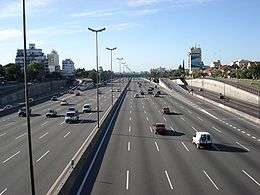
According to a 2004 report from the World Health Organisation a total of 22% of all 'injury mortality' worldwide were from road traffic injuries in 2002[n 4] and without 'increased efforts and new initiatives' casualty rates would increase by 65% between 2000 and 2020.[n 5] The report identified that the speed of vehicles was 'at the core of the problem[n 6] and said that speed limits should be set appropriately for the road function and design along with physical measures related to the road and the vehicle and effective enforcement by the police.[n 7] Road incidents are said to be the leading cause of deaths among children 10 – 19 years of age (260,000 children die a year, 10 million are injured).[92] They are also occasionally set to reduce vehicle emissions or fuel use.
Maximum speed limits place an upper limit on speed choice and if obeyed can reduce the differences in vehicle speeds by drivers using the same road at the same time.[93] Traffic engineers observe that the likelihood of a crash happening is significantly higher if vehicles are traveling at speeds faster or slower than the mean speed of traffic;[94] when severity is taken into account the risk is lowest for those traveling at or below the median speed and "increases exponentially for motorists travelling much faster".[n 8]

It is desirable to attempt to reduce the speed of road vehicles in some circumstances because the kinetic energy involved in a motor vehicle collision is proportional to the square of the speed at impact. The probability of a fatality is, for typical collision speeds, empirically correlated to the fourth power of the speed difference (depending on the type of collision, not necessarily the same as travel speed) at impact,[95] rising much faster than kinetic energy.
Typically motorways have higher speed limits than conventional roads because motorways have features which decrease the likelihood of collisions and severity of impacts. For example, motorways separate opposing traffic and crossing traffic, employ traffic barriers, and prohibit the most vulnerable users such as pedestrians and bicyclists. Germany's crash experience illustrates the relative effectiveness of these strategies on crash severity: on autobahns 22 people died per 1000 injury crashes, a lower rate than the 29 deaths per 1,000 injury accidents on conventional rural roads; however, the rural risk is five times higher than on urban roads – speeds are higher on rural roads and autobahns than urban roads, increasing the severity potential of a crash.[96] The net effect of speeds, crash probability, and impact mitigation strategies may be measured by the rate of deaths per billion-travel-kilometers: the autobahn fatality rate is 2 deaths per billion-travel-kilometers, lower than either the 8.7 rate on rural roads or the 5.3 rate in urban areas; the overall national fatality rate was 5.6, slightly higher than urban rate and more than twice that of autobahns.[97]
The 2009 technical report An Analysis of Speeding-Related Crashes:Definitions and the Effects of Road Environments by the National Highway Traffic Safety Administration showed that about 55 percent of all speeding-related crashes in fatal crashes had "exceeding posted speed limits" among their crash factors, and 45 percent had "driving too fast for conditions" among their crash factors. However, the authors of the report did not attempt to determine whether the factors were actually a crash cause, contributor, or an unrelated factor.[98] Furthermore, separate research finds that only 1.6% of crashes are "caused" by drivers that exceed the posted speed limit.[99] Finally, exceeding the posted limit may not be a remarkable factor in crash analysis as there exist roadways where virtually all motorists are in technical violation of the law.[100]
The speed limit will also take note of the speed at which the road was designed to be driven (the design speed) which is defined in the US as "a selected speed used to determine the various geometric design features of the roadway"[101] However traffic engineers recognize that "operating speeds and even posted speed limits can be higher than design speeds without necessarily compromising safety"[102] since design speed is "based on conservative assumptions about driver, vehicle and roadway characteristics".[48]
Vision Zero, which envision reducing road fatalities and serious injuries to zero by 2020, suggests the following "possible long term maximum travel speeds related to the infrastructure, given best practice in vehicle design and 100% restraint use":[103]
| Type of infrastructure and traffic | Possible travel speed (km/h) |
|---|---|
| Locations with possible conflicts between pedestrians and cars | 30 km/h (19 mph) |
| Intersections with possible side impacts between cars | 50 km/h (31 mph) |
| Roads with possible frontal impacts between cars, including rural roads[104] | 70 km/h (43 mph) |
| Roads with no possibility of a side impact or frontal impact (only impact with the infrastructure) | 100 km/h (62 mph)+ |
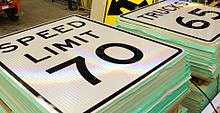
"Roads with no possibility of a side impact or frontal impact" are sometimes designated as Type 1 (motorways/freeways/Autobahns), Type 2 ("2+2 roads") or Type 3 ("2+1 roads").[105] These roadways have crash barriers separating opposing traffic, limited access, grade separation and prohibitions on slower and more vulnerable road users. Undivided rural roads can be quite dangerous even with speed limits that appear low by comparison. For example, in 2011, Germany's 100 km/h (62 mph)-limited rural roads had a fatality rate of 8.7 deaths per billion travel-km, over four times higher than the autobahn rate of 2 deaths.[97] Autobahns accounted for 31% of German road travel in 2011,[97] but just 11% (453 of 4,009) of traffic deaths.
Fuel efficiency
Fuel efficiency sometimes affects speed limit selection. The United States instituted a National Maximum Speed Law of 55 mph (89 km/h) as part of the Emergency Highway Energy Conservation Act in response to the 1973 oil crisis to reduce fuel consumption.[106] According to a report published in 1986 by The Heritage Foundation, a Conservative advocacy group, the law was widely disregarded by motorists and hardly reduced consumption at all.[107] In 2009 The American Trucking Associations called for a 65 mph speed limit and also national fuel economy standards claiming that the lower speed limit was not effective at saving fuel.[108] European studies have claimed that, whereas the effects of specific speed reduction schemes on particulate emissions from trucks are ambiguous, lower maximums speed for trucks consistently result in lower emissions of CO2 and better fuel efficiency.[109]
Environmental considerations
Speed limits can also be used to improve local air quality issues or other factors affecting environmental quality[109] for example the "environmental speed limits" in the United States including one in an area of Texas.[110]
The European Union is also increasingly using speed limits as in response to environmental concerns.[91]
Advocacy
Speed limits, and especially some of the methods used to attempt to enforce them, have always been controversial. There are a variety of notable organisations and individuals who, for a variety of often passionately held views, oppose or support the use of speed limits or the way they are enforced.
Opposition
Speed limits, and their enforcement have been opposed by various groups and for various reasons since their inception. Historically, the AA was formed in 1905, initially to warn members about speed traps.[111]
In more recent times some advocacy groups seek to have certain speed limits as well as other measures removed. For example, automated camera enforcement has been criticised by motoring advocacy groups the Association of British Drivers,[112][113] the North American National Motorists Association,[114][115] and the German Auto Club.[116]
Arguments used by those advocating a relaxation of speed limits or their removal include:
- A 1994 peer-reviewed paper by Charles A. Lave et al. titled Did the 65 mph Speed Limit Save Lives? stated that evidence that a higher speed limit may be positive on a system wide in the United States by shifting more traffic to these safer roads.[117]
- A 1998 report in the Wall Street Journal title 'Highways are safe at any speed' stated that when speed limits are set artificially low, tailgating, weaving and speed variance (the problem of some cars traveling significantly faster than others) make roads less safe.[118]
- In 2010, German Auto Club (a major motoring organisation) argued that an autobahn speed limit was unnecessary because numerous countries with a general highway speed limit had worse safety records than Germany, for example Denmark, Belgium, Austria, and the United States.[116]
- In 2008, the German Automobile Manufacturer's Association called general limits "patronizing",[119] arguing instead for variable speed limits. The Association also stated that "raising the speed limits in Denmark (in 2004 from 110 km/h to 130 km/h)[120][121] and Italy (2003 increase on six-lane highways from 130 km/h to 150 km/h) had no negative impact on traffic safety. The number of accidental deaths even declined".[122]
- Safe Speed, a UK advocacy organisation campaigns for higher speed limits[123] and to scrap speed cameras on the basis that the benefits were exaggerated and that they may actually increase casualty levels;[124] their ePetition to the UK government in 2007 calling for speed cameras to be scrapped received over 25,000 signatures.[125]
Support
Various other advocacy groups press for stricter limits and better enforcement. The Pedestrians Association was formed in the United Kingdom in 1929 to protect the interests of the pedestrian. Their president published a critique of motoring legislation and the influence of motoring groups in 1947 title 'Murder most foul' which laid out in an emotional but detailed way the situation as they saw it and called for tighter speed limits.[126] Historically, the Pedestrians' Association and the Automobile Association were described as "bitterly opposed" in the early years of United Kingdom motoring legislation.[127] More recently organisations such as RoadPeace, Twenty is Plenty, and Vision Zero have campaigned for lower speed limits in residential areas.
Signage
In most of the world speed limit signs display the limitation within a red circle. This design follows the style set out by the Vienna Convention on Road Signs and Signals, with the exception of United States and Canada. All countries globally worldwide (except the United Kingdom and United States) use metric speed limits in kilometres per hour. Metric signs are optional in the United States though less commonly seen, while Samoa uses both units. In Ontario, Canada, the type, location, and frequency of speed limit signs is covered by regulation 615 of the Ontario Highway Traffic Act.[128]
Maximum speed limit
 Speed limit sign for 50 km/h (Vienna Convention Sign C14, most of the world follows this pattern)
Speed limit sign for 50 km/h (Vienna Convention Sign C14, most of the world follows this pattern) UK sign for 50 mph
UK sign for 50 mph.svg.png)
 Alternative Vienna Convention sign with a yellow background used in some countries, such as Sweden, Finland and Iceland
Alternative Vienna Convention sign with a yellow background used in some countries, such as Sweden, Finland and Iceland Ireland includes the symbol "km/h" since going metric in 2005
Ireland includes the symbol "km/h" since going metric in 2005.svg.png) Japan uses blue numerals
Japan uses blue numerals

 Canada (displayed in km/h)
Canada (displayed in km/h) Canada (Ontario)
Canada (Ontario) Canada (Yukon and British Columbia)
Canada (Yukon and British Columbia) United States (in mph)
United States (in mph) United States (Oregon variant)
United States (Oregon variant) United States (metric)
United States (metric)
Minimum speed limit
Minimum speed limit signs are usually a blue circle with a white border and the limit in white. Some South American countries (e.g.: Argentina), use a red border. Japan and South Korea use their normal speed limit sign, with a line below the limit.
 Common minimum speed limit sign
Common minimum speed limit sign


.svg.png)

.svg.png)
.svg.png)


 United States (dual maximum and minimum speeds)
United States (dual maximum and minimum speeds) United States (metric)
United States (metric) United States (metric, dual maximum and minimum speeds)
United States (metric, dual maximum and minimum speeds)
Special speed limits
In some countries, speed limits may apply to certain classes of vehicles, or special conditions such as night-time. Usually these speed limits will be reduced from the normal limit for safety reasons.
 Australia - Speed limit during certain times
Australia - Speed limit during certain times Australia - Road Train speed limit
Australia - Road Train speed limit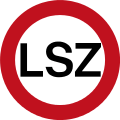 New Zealand - Limited Speed Zone (Maximum speed limit is 100 km/h, reduces to 50 km/h if dangerous conditions exist such as bad weather)
New Zealand - Limited Speed Zone (Maximum speed limit is 100 km/h, reduces to 50 km/h if dangerous conditions exist such as bad weather) Romania - Trucks speed limit
Romania - Trucks speed limit United States - Roadworks zone speed limit
United States - Roadworks zone speed limit United States - Trucks speed limit
United States - Trucks speed limit United States - Towed vehicles speed limit
United States - Towed vehicles speed limit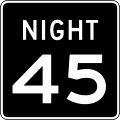 United States - Night time speed limit
United States - Night time speed limit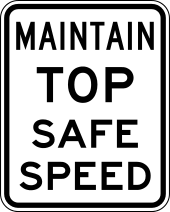 Unique speed limit sign in the United States on evacuation routes requiring drivers to maintain the maximum safe speed
Unique speed limit sign in the United States on evacuation routes requiring drivers to maintain the maximum safe speed
Speed limit derestriction
In some countries, derestriction signs are used to mark where a speed zone ends. The speed limit beyond the sign is the prevailing limit for the general area, for example the sign might be used to show the end of an urban area. In the United Kingdom, the sign means that the national speed limit applies (60 mph on open roads, 70 mph on dual carriageways and motorways). In New Zealand it means you are on an open road, but the maximum legal speed of 100 km/h still applies[129] On roads without a general speed limits, such as German Autobahn, a portion of Stuart Highway, and rural areas on the Isle of Man, it really means end of all quantitative speed limits.
 Common maximum speed limit derestriction sign
Common maximum speed limit derestriction sign Common minimum speed limit derestriction sign
Common minimum speed limit derestriction sign Common advisory speed limit derestriction sign
Common advisory speed limit derestriction sign
 Australia
Australia Belgium, United Kingdom, Republic of Ireland pre-2005, New Zealand, Singapore, Malaysia and Switzerland
Belgium, United Kingdom, Republic of Ireland pre-2005, New Zealand, Singapore, Malaysia and Switzerland

.svg.png)

 United States (archaic)
United States (archaic)
Advisory speed limit
Advisory speed limits may provide a safe suggested speed in an area, or warn of the safe maximum speed for dangerous curves.
See also
- Advisory speed limit
- Assured Clear Distance Ahead (ACDA)
- Design speed
- Functional classification
- Negligence per se
- Operating speed
- Radar speed sign
- Solomon curve
- Speed limits by country
- Stopping sight distance
- Traffic violations reciprocity
- Traffic psychology
Notes
- ↑ World Health Organisation (2004) p. foreword, "In high-income countries, an established set of interventions have contributed to significant reductions in the incidence and impact of road traffic injuries. These include the enforcement of legislation to control speed and alcohol consumption, mandating the use of seat-belts and crash helmets, and the safer design and use of roads and vehicles."
- 1 2 3 Table 3, J. Stuster and Z. Coffman, Synthesis of Safety Research Related to Speed and Speed Management , FHWA-RD-98-154, July 1998
- ↑ Federal Highway Administration (1998) p. 2 'In general, changing speed limits on low and moderate speed roads appears to have little or no effect on speed and thus little or no effect on crashes, thereby suggesting that drivers travel at speeds they feel are reasonable and safe for the road and traffic regardless of the posted limit. However, on freeways and other high-speed roads, speed limit increases generally lead to higher speeds and crashes. The change in speed is roughly one-fourth the change in speed limit. Results from international studies suggest that for every 1 mi/h change in speed, injury accidents will change by 5 percent (3 percent for every 1 km/h). However limited evidence suggests the net effect of speed limits may be positive on a system wide basis.'
- ↑ World Health Organisation (2004) p. 34 fig 2.1
- ↑ World Health Organisation (2004) p. 3
- ↑ World Health Organisation (2004) p. 76
- ↑ World Health Organisation (2004) p. 127
- ↑ Federal Highway Administration (1998) p. 2 'When the consequences of crashes are taken into account, the risk of being involved in an injury crash is lowest for vehicles that travel near the median speed or slower and increases exponentially for motorists traveling much faster'
References
- Documents referenced from 'Notes' section
- Federal Highway Administration (1998). "Synthesis of Safety Research Related to Speed and Speed Limits" (PDF). Retrieved 2013-09-23.
- British Columbia Ministry of Transportation (2003). "Review and Analysis of Posted Speed Limits and Speed Limit Setting Practices in British Columbia" (PDF). Retrieved 2009-09-17.
- World Health Organisation (2004). "World report on road traffic injury prevention". Retrieved 2010-04-13.
- Department for Transport (2008). "Reported Road Casualties Great Britain: 2008 Annual Report" (PDF). Retrieved 2010-01-09.
- Other references for article
- ↑ http://www.autostrada-a4.pl/safety/traffic-rules
- ↑ http://www.novinite.com/view_news.php?id=140674
- ↑ http://abcnews.go.com/US/speeding-texas-85-mph-highway-opens/story?id=17549839
- ↑ "Current speed limit policies". European Commission. Retrieved 2010-04-23.
- ↑ "Auswirkungen eines allgemeinen Tempolimits auf Autobahnen im Land Brandenburg" (PDF). Brandenburg. October 2007. Retrieved 2010-12-04.
(German)Auf einer 6-streifigen Autobahn ergibt sich für den Pkw-Verkehr im Mittel eine Geschwindigkeit von 142 km/h. (English)On clear stretches of 6-lane highway, cars average a speed of 142 km / h
- 1 2 "No All-Island Speed Limit". Isle of Man Guide. 6 November 2004. Retrieved 2009-09-17.
- ↑ "The Table of Maximum Speed Limits at a Glance" (PDF).
- ↑ http://www.mahatranscom.in/faq.aspx
- ↑ http://www.transport.telangana.gov.in
- ↑ "The impact of lowered speed limits in urban and metropolitan areas" (PDF).
- ↑ Criminal on the Road:A Study of Serious Motoring Offences and Those Who Commit Them. Routledge. 1964. p. 64. ISBN 0415264162.
- ↑ "Motoring firsts". National Motoring Museum.
- ↑ Adam Hart Davis. "The Eureka Years". BBC Radio 4.
- ↑ "US History, Criminal Justice, The first speeding ticket".
- ↑ "Keeping Order: Motor-Car Regulation and the Defeat of Victoria's 1905 Motor-Car Bill".
On 7 April 1905, E Norton Grimwade ...appeared in the District Court [charged with] ‘furious’ driving [because] he passed a tram ... Several people ... [estimated] the car’s speed at 20 mph ... It was going twice as fast as the tram.
- ↑ "An Analysis of Speeding-Related Crashes:Definitions and the Effects of Road Environments" (PDF). U.S. Department of Transportation, National Highway Traffic Safety Administration. February 2009. Retrieved 2010-04-25.
Appendix: The basic rules governing speed of vehicles in Kansas, Kentucky, Maryland, Montana, North Carolina, and Wisconsin.
- ↑ "Road Traffic Act 1991". Office of Public Sector Information. Retrieved 2010-05-03.
A person is guilty of an offence if he intentionally and without lawful authority or reasonable cause— (a) causes anything to be on or over a road, or (b) interferes with a motor vehicle, trailer or cycle, or (c) interferes (directly or indirectly) with traffic equipment, in such circumstances that it would be obvious to a reasonable person that to do so would be dangerous. (2) In subsection (1) above "dangerous" refers to danger either of injury to any person while on or near a road, or of serious damage to property on or near a road; and in determining for the purposes of that subsection what would be obvious to a reasonable person in a particular case, regard shall be had not only to the circumstances of which he could be expected to be aware but also to any circumstances shown to have been within the knowledge of the accused.
- ↑ http://www.gesetze-im-internet.de/stvo_2013/__3.html
- ↑ 49 CFR 392.14
- ↑ "State v. Stanko". Supreme Court of Montana. 1998.
- ↑ "Section 2 – Driving Safely" (PDF). Commercial Driver License Manual 2005. United States Department of Transportation. July 2014. pp. 2–15, 2–19, 2–26, 13–1.
[pg 2-15] 2.6.4 – Speed and Distance Ahead: You should always be able to stop within the distance you can see ahead. Fog, rain, or other conditions may require that you slowdown to be able to stop in the distance you can see. ... [pg 2-19] 2.8.3 – Drivers Who Are Hazards: Vehicles may be partly hidden by blind intersections or alleys. If you only can see the rear or front end of a vehicle but not the driver, then he or she can't see you. Be alert because he/she may back out or enter into your lane. Always be prepared to stop. ... [pg 2-26] 2.11.4 – Vehicle Factors: Headlights. At night your headlights will usually be the main source of light for you to see by and for others to see you. You can't see nearly as much with your headlights as you see in the daytime. With low beams you can see ahead about 250 feet and with high beams about 350-500 feet. You must adjust your speed to keep your stopping distance within your sight distance. This means going slowly enough to be able to stop within the range of your headlights. ... [pg 13-1] 13.1.2 – Intersections As you approach an intersection: Check traffic thoroughly in all directions. Decelerate gently. Brake smoothly and, if necessary, change gears. If necessary, come to a complete stop (no coasting) behind any stop signs, signals, sidewalks, or stop lines maintaining a safe gap behind any vehicle in front of you. Your vehicle must not roll forward or backward. When driving through an intersection: Check traffic thoroughly in all directions. Decelerate and yield to any pedestrians and traffic in the intersection. Do not change lanes while proceeding through the intersection. Keep your hands on the wheel.
- ↑ "California Vehicle Code section 22350: Basic Speed Law". California Department of Motor Vehicles. September 20, 1963. Retrieved 2010-04-25.
No person shall drive a vehicle upon a highway at a speed greater than is reasonable or prudent having due regard for weather, visibility, the traffic on, and the surface and width of, the highway, and in no event at a speed which endangers the safety of persons or property.
- ↑ "On Gravel Roads, People Drive At Speed They Are Comfortable With, Regardless Of Posted Limit". Retrieved 2010-10-13.
"We found that people are driving at speeds based on their perceptions and existing conditions – regardless of the speed limit," said Dissanayake, who also is a faculty member with K-State's University Transportation Center...when it came to speed limits and the actual speeds driven, the difference was not significant between 35 mph and 55 mph roads. An example is the gravel roadways in Johnson County and Miami County. The study found that though two speed limits exist, the driving characteristics were the same. While Johnson County's speed limit is 35 mph and posted, the average actual speed of 37.5 mph was higher than the average actual speed of 35.8 mph in Miami County, where the speed limit is 55 mph and not posted.
- ↑ "Hatzakorzian v. Rucker-Fuller Desk Co., 197 Cal. 82". Official California Reports, Vol. 197, p. 82 (California Supreme Court reporter). September 21, 1925.
Under the circumstances of the present case -- the narrowness of the unpaved portion of the highway, the darkness of the night and the blinding of Kennell by the glare of the lights reflected from the headlights of the approaching machine -- the highway over which Kennell was traveling was beset by danger of an extraordinary character from the time his vision became so obscured as to make it impossible for him to see plainly the road before him to the time that he struck the deceased. Thus the ordinary care with which Kennell was charged in driving his car over the highway required such an amount of such care as was commensurate with the exactions of the extraordinary dangerous circumstances under which he was then operating his car. The respective rights and duties of drivers of automobiles and other vehicles and of pedestrians have repeatedly been by the courts of this state clearly pointed out..
- ↑ "Allin v. Snavely, 100 Cal. App. 2d 411". Official California Appellate Reports (2nd Series Vol. 100, p. 411). November 14, 1950. Retrieved 2013-07-27.
"A driver by insisting on his lawful right of way may violate the basic speed law as provided by Veh. Code, § 22350, and thus become guilty of negligence."(CA Reports Headnote #[2])
- ↑ "Riggs v. Gasser Motors, 22 Cal. App. 2d 636". Official California AppellateReports (2nd Series Vol. 22, p. 636). September 25, 1937. Retrieved 2013-07-27.
It is common knowledge that intersecting streets in cities present a continuing hazard, the degree of hazard depending upon the extent of the use of the intersecting streets and the surrounding circumstances or conditions of each intersection. Under such circumstances the basic [speed] law...is always governing.
See Official Reports Opinions Online - ↑ "Leeper v. Nelson, 139 Cal. App. 2d 65". Official California Appellate Reports (2nd Series Vol. 139, p. 65). Feb 6, 1956. Retrieved 2013-07-27.
The operator of an automobile is bound to anticipate that he may meet persons or vehicles at any point of the street, and he must in order to avoid a charge of negligence, keep a proper lookout for them and keep his machine under such control as will enable him to avoid a collision with another automobile driven with care and caution as a reasonably prudent person would do under similar conditions.
See Huetter v. Andrews, 91 Cal. App. 2d 142, Berlin v. Violett, 129 Cal.App. 337, Reaugh v. Cudahy Packing Co., 189 Cal. 335 , and Official Reports Opinions Online - ↑ "Reaugh v. Cudahy Packing Co., 189 Cal. 335". Official California Reports, Vol. 189, p. 335, (California Supreme Court reporter). July 27, 1922. Retrieved 2013-07-27.
This is but a reiteration of the rule, in statutory form, which has always been in force without regard to a statutory promulgation to the effect that drivers or operators of vehicles, and more particularly motor vehicles, must be specially watchful in anticipation of the presence of others at places where other vehicles are constantly passing, and where men, women, and children are liable to be crossing, such as corners at the intersections of streets or other similar places or situations where people are likely to fail to observe an approaching automobile.
- 1 2 www.destatis.de (10 July 2013). "Unfallentwicklung auf deutschen Straßen 2012 (Crashes on German Roads 2012)" (PDF). Statistisches Bundesamt (Federal Statistics Office). Statistisches Bundesamt. Retrieved 2013-09-23.
(Seite 19) Mit 29 Getöteten je 1 000 Unfälle mit Personenschaden ist das Todesrisiko auf Landstraßen fünfmal höher als auf Innerortsstraßen und auch höher als auf Autobahnen, auf denen 22 Personen je 1000 Unfälle starben. Ein Grund für das wesentlich höhere Risiko auf Landstraßen und Autobahnen ist, dass hier wesentlich schneller gefahren wird als auf Innerortsstraßen und dadurch die Unfallschwere steigt.. (Seite 20) Hauptunfallursache auf Autobahnen ist die "nicht angepasste Geschwindigkeit". Im Jahr 2012 waren mehr als ein Drittel aller Unfälle mit Personenschaden auf Autobahnen Unfälle, bei denen mindestens einem Beteiligten dieses Fehlverhalten zur Last gelegt wurde. Bei insgesamt 6 587 sogenannten Geschwindigkeitsunfällen kamen 179 Menschen zu Tode, das heißt nahezu die Hälfte (46,3 %) aller Getöteten auf Autobahnen... (Seite 20) Hierbei ist allerdings zu berücksichtigen, dass die Unfallursache "nicht angepasste Geschwindigkeit" häufig nicht bedeutet, dass die zulässige Höchstgeschwindigkeit überschritten worden ist. "Nicht angepasste Geschwindigkeit" wird von der Polizei bei einem Unfall auch dann als Ursache erfasst, wenn ein Beteiligter für die vorliegenden Straßen- oder Witterungsverhältnisse zu schnell gefahren ist.
Check date values in:|year= / |date= mismatch(help) - ↑ "A 95: Polizei geschockt über "immenses Tempo" [Translation: A 95: Police Shocked At High Speed]". Merkur Online [The Mercury online version]. Aug 5, 2013. Retrieved 2013-09-29.
den stellvertretenden Kommandanten der Feuerwehr aus Hohenschäftlarn (Kreis München), Daniel Buck... war mit seinen Kollegen einer der ersten an der Unfallstelle, an der ein Porschefahrer (51) so schnell in den Toyota einer 67-jährigen Weilheimerin bretterte, dass sich ihr Auto mehrmals überschlug. Die Frau musste noch vor Ort reanimiert werden, starb jedoch später im Krankenhaus. Die beiden Männer im Porsche kamen mit leichten Verletzungen davon... Auf Höhe des Dreiecks Starnberg verlor er auf der linken Spur die Kontrolle über sein Auto. Er kam ins Schleudern, schoss rechts über einen Grünstreifen und kam auf dem Zubringer aus Starnberg wieder auf die Fahrbahn. Dort rammte er die 67-jährige Weilheimerin in ihrem Toyota... Zeugen vor Ort schätzen, dass der Sportwagen mit rund 300 Kilometer pro Stunde unterwegs war... Ein Zeuge hatte seinen Tempomat auf 140 Stundenkilometer eingestellt und war von dem Sportwagen überholt worden. "Er schätzt, der Porsche war doppelt so schnell", sagt Buck. Und: "...Schneller wie 160 Kilometer pro Stunde ist hier absolut unangemessen.". [Translation: deputy commander of the fire brigade from Hohenschaeftlarn county (Munich), Daniel Buck...was one of the first with his colleagues at the accident site where a Porsche driver (age 51) bashed into the Toyota driven by a 67-year-old Weilheim in Oberbayern resident, rolling her car over several times. The woman had to be resuscitated on site, but died later in hospital. The two men in the Porsche escaped with minor injuries... At the peak of the Starnberg interchange in the left lane he lost control of his car. He went into a skid, shot right through a grass strip to ram the 67-year-old Weilheimer resident in her Toyota... Witnesses on site estimated that the sports car was traveling about 300 kilometers per hour... One witness had his cruise control set at 140 kilometers per hour and was overtaken by the sports car. "He estimates the Porsche was twice as fast," says Buck. And: "This is simply irresponsible; even as fast as 160 kilometers per hour is absolutely inappropriate. "]
- ↑ "Autobahn Pileup: 52-Car German Crash Kills 3 (VIDEO)". Huffington Post. 2011-11-19.
- ↑ https://www.fmcsa.dot.gov/about/outreach/education/driverTips/Too-Fast-for-Conditions-all.htm
- ↑ Kennedy, Maev (6 September 2013). "'All you could hear was cars crashing': 120-car pile-up on Sheppey bridge". The Guardian.
- ↑ http://www.fox19.com/story/20639696/girl-12-killed-in-86-car-pileup-on-i-275
- ↑ http://sanatogapost.com/2013/07/10/detectives-excessive-speed-factor-in-422-crash-death/
- ↑ "Kyle Stein charged in Colerain Twp. crash that killed Rachel McGrath and Eric Moormann]]".
[The teenage driver] lost control of the vehicle on a "curvy portion" of Sheed Road in Colerain Township and struck a parked Ford Titanium. The crash killed both .. passengers [, the driver] was traveling in excess of the posted 35 mph speed limit in order to "catch up to a new model Audi R8 to get a better look at this very expensive vehicle"
- ↑ http://www.freep.com/article/20131013/NEWS06/310130122/
- ↑ "No sign of alcohol for 6 teens killed in OH crash".
the SUV was traveling between 62 mph and 70 mph on a 35-mph road before it flipped into a pond in a dark, unlit area in Warren on March 10 [, 2013], killing the 19-year-old driver and five of the seven boys riding with her
- ↑ "Speeding Counts on All Roads" (PDF). FHWA Safety (November 2000).
almost 50 percent of speeding-related fatalities occur on lower speed collector and local roads, which carry only 28.1 percent of the total vehicle miles traveled in the United States... the deadly consequences of speeding on local and collector roads becomes even more dramatic. The speeding fatality rate for local roads is three times that for Interstates
- ↑ http://www.pe.com/articles/speed-776756-survey-limit.html
- ↑ http://caselaw.findlaw.com/mt-supreme-court/1110919.html
- ↑ http://vincenzeslaw.com/4-ways-virginia-reckless-driving-charges-handled-differently-fairfax-county-arlington-alexandria-stafford/
- ↑ "Traffic Operations : Road Signs". Government of South Australia. 2002-08-23 (last update date). Retrieved 2010-09-26.
Most regulatory signs are rectangular with a black legend on a white background...[exceptions include] speed restriction signs (symbol enclosed in a red circle)"
Check date values in:|date=(help) - ↑ "Speed Zoning Information" (PDF). Institute of Transportation Engineers. 22 March 2004. Retrieved 2009-09-17.
- ↑ MUTCD Sections 2B.13-16 #12
- ↑ "California Vehicle Code § 21400(b)". The State of California. January 1, 2012. Retrieved 2013-07-28.
- ↑ Transportation Research Board of the National Academies; Kay Fitzpatrick; Paul Carlson; Marcus A. Brewer; Mark D. Wooldridge; Shaw-Pin Miaou; Texas Transportation Institute (October 6, 2003). NCHRP Report 504 – Design Speed, Operating Speed, and Posted Speed Practices (PDF). onlinepubs.trb.org. Washington, D.C.: National Academies Press. p. 88. ISBN 0-309-08767-8. ISSN 0077-5614. Archived (PDF) from the original on April 12, 2014. Retrieved 2009-09-16.
- 1 2 http://tti.tamu.edu/documents/1465-1.pdf
- ↑ http://azdot.gov/business/engineering-and-construction/traffic/faq/establishing-speed-limits
- ↑ http://www.ksdot.org/bureaus/burTrafficSaf/brochures/establishingspeedlimits.asp
- ↑ Public opposition to speed limits being set by an authority, often arise because such agency has been viewed as abusing its power--such as by arbitrary indiscretion or by creating "speed traps." Because an expert can theoretically calculate a safer speed limit, than the populace's vote by driving, it is beneficial that local governments preserve strong public trust with their integrity in speed regulation. See A Policy on Geometric Design of Highways and Streets, AASHTO, 4th Ed., 2001; ISBN 1-56051-156-7
- ↑ USLIMITS2: A Tool to Aid Practitioners in Determining Appropriate Speed Limit Recommendations
- ↑ "Riggs v. Gasser Motors, 22 Cal. App. 2d 636". Official California Appellate Reports (2nd Series, Vol. 22, p. 22). September 25, 1937.
- ↑ "Alarid v. Vanier, 50 Cal.2d 617". Official California Reports, 2nd Series Vol. 50, p. 617 (California Supreme Court reporter). July 17, 1958. See Official California Reports online
- ↑ "Speeds on Rural Interstate Highways Relative to Posting the 40 mph Minimum Speed Limit". U.S. Bureau of Transportation Statistics (BTS). 2004. Retrieved 2010-09-29.
The relevance of posting the 40 mile per hour (mph) minimum speed limit on the Interstate Highway System has been increasingly called into question since the National Highway System Designation Act of 1995 repealed the federally sanctioned maximum speed limit. In this study, data were collected on major interstate highways in Florida to evaluate speed distribution relative to the 40 mph posted minimum speed limit. The data revealed that the 15th percentile speed at all sites was 60 mph or above on both four-lane and six-lane highway sections. The analysis showed that the average speed at all sites was approximately 5 standard deviations above the 40 mph minimum.
- ↑ Peter Schick (June 2003), (translation) "Influence of Traffic Control Systems on Freeway Capacity and Stability of Traffic Flow"; Original Title "Einfluss von Streckenbeeinflussungsanlagen auf de Kapazitaet von Autobahnabschnitten sowie die Stabilitaet des Verkehrsflusses" (PDF), University of Stuttgart, p. 20, retrieved 2010-10-16,
(translation) "The first experiment was carried out in 1965 on a 30 km section of the A8 from Salzburg to Munich. The system consisted of mechanically variable message signs at a distance of 2 km, which could display speeds of 60, 80 and 100 km/h, and "danger zone" and "accident". Personnel monitored traffic using video technology, and manually controlled the signage. Studies reported a decrease in traffic disruptions and breakdowns, harmonization of the velocity distribution and an increase in performance (Zackor 1972, see also Chapter 3.2.2)." German text: "Die erste linienhafte Beeinflussung des Verkehrs erfolgte im Jahr 1965 durch die Errichtung einer Wechselverkehrszeichenanlage auf einem 30 km langen Abschnitt der A8 auf der Richtungsfahrbahn Salzburg – München. Die Anlage bestand aus neben der Fahrbahn angebrachten mechanischen Wechselverkehrszeichen im Abstand von 2 km, die StVO-gerechte Zeichen für die Geschwindigkeitsbegrenzungen 60, 80 und 100 km/h sowie "Gefahrstelle" und "Unfall" anzeigen konnten (Abb. 2-1). Diese Zeichen wurden vom Betreiberpersonal, das mittels Videotechnologie eine Übersicht über das Verkehrsgeschehen hatte, manuell geschaltet. Somit konnte erstmals auf einer Autobahn die Geschwindigkeit des Verkehrs beeinflusst sowie eine Unfallwarnung vorgenommen werden. Die ersten Erfahrungen und wissenschaftlichen Untersuchungen berichten von einer Abnahme der Störungen und Verkehrszusammenbrüche, einer Harmonisierung der Geschwindigkeitsverteilung sowie einer Steigerung der Leistungsfähigkeit (ZACKOR 1972, siehe auch Kapitel 3.2.2).
- ↑ Ralf Schmahld (6 August 2009), (translation) "20 years waiting in traffic jams"; Original Title "20 Jahre im Stau gestanden", Reise (Travel) magazine, retrieved 2010-10-16,
(translation) "A total of 1,300 kilometers of motorways now have traffic control systems for the harmonization of traffic flow by speed limits and traffic warning, and the government expects to expand their use: 2500 km stretch of motorway could be controlled by these dynamic control systems." German text: "An insgesamt 1.300 Kilometern der Bundesautobahnen seien inzwischen Streckenbeeinflussungsanlagen zur Harmonisierung des Verkehrsablaufs durch Geschwindigkeitsbeschränkungen und Gefahrenwarnung installiert worden, teilt die Regierung weiter mit. 2.500 Kilometer Autobahnstrecke könnten mittels dynamischer Netzbeeinflussungsanlagen gesteuert werden"
- ↑ Mark Robinson, P.E. (January 9, 2000), Examples of Variable Speed Limit Applications. Speed Management Workshop (PDF), Transportation Research Board. 79th Annual Meeting, retrieved 2010-10-17,
"New Jersey. Status: Active (installed in the late 1960s). Objective: to provide early warning to motorists of slow traffic or hazardous road conditions. Setting: Urban/Rural - New Jersey Turnpike.
- 1 2 http://ntl.bts.gov/lib/jpodocs/briefing/12164.pdf
- ↑ "WYDOT proposes to lower I-80 speed limit". KSL-TV. September 29, 2008. Retrieved 2010-10-16.
The Wyoming Department of Transportation says it plans to impose a speed limit of 65 mph on a 52-mile stretch of the interstate between Laramie and Rawlins. The reduction from the existing speed limit of 75 mph will take effect Oct. 15 and continue for six months. In addition, WYDOT intends to install variable speed-limit signs on the same stretch of highway so the limit can be lowered further because of bad weather. The section is between the Quealy Dome Interchange, 20 miles west of Laramie, and the Peterson Interchange, 22 miles east of Rawlins, the agency said.
- ↑ "Wyoming seasonal speed limit will vary with conditions". Land Line Magazine. October 15, 2010. Retrieved 2010-10-16.
"When it’s all horizontal and drifts, it kills the visibility, and we have a horrible time trying to keep people on the road," Wyoming DOT engineer Tim McGary told Land Line Now on Sirius XM. McGary says this winter, truckers on I-80 will no longer see that 65 mph seasonal speed limit between Laramie and Rawlins. Instead, the whole 52-mile stretch will have the electronic, variable speed limit signs that the DOT started installing last year. The variable signs allow the DOT to lower or raise the speed limit in 5 mph increments depending on the weather conditions. And McGary says they work. The statistics are kind of showing that if we’re on top of things with our plow operators and troopers out there, and we get the speed limits reduced appropriately to the weather conditions, people are complying pretty well with that," McGary said. "Our crash rates have gone down and we’re hoping to continue that trend."
- ↑ 'Saha, P., and Young, R. (2014). 'Weather-Based Safety Analysis for the Effectiveness of Rural Variable Speed Limit (VSL) Corridors ' In Transportation Research Board 93rd Annual Meeting (No. 14-2293), http://docs.trb.org/prp/15-1916.pdf
- ↑ 'R. Young, V. Sabawat, P. Saha, Y. Sui (2014). 'Rural Variable Speed Limits: Phase II'
- ↑ "Managing Speed". Public Roads. www.tfhrc.gov. January–February 2003. Retrieved 2008-07-06.
- ↑ "Tennessee Low Visibility Warning System" (PDF). Federal Highway Administration. Retrieved 2010-10-17.
- ↑ Report (HC 15, 2004-05): Tackling congestion by making better use of England's motorways and trunk roads (Full Report) (PDF), National Audit Office, 26 November 2004, p. 21, retrieved 2009-09-17,
The initial results of the one year trial of Variable Speed Limits indicated savings in journey times, smoother flowing traffic and a fall in the number of accidents. On the basis of these findings, the Agency converted the trial into a permanent facility in 1997. Variable Speed Limits have generally been popular with road users who have reported perceived benefits, including less congestion and less stressful journeys. Yet the Agency could not prove a business case to use the measure elsewhere. Conditions at the site of the Variable Speed Limits trial were not stable before or during the trial, or in the period of extended monitoring that followed it. Traffic volumes changed and the Agency introduced new technology and new lighting and widened the motorway at both ends of the trial site, preventing it from establishing properly controlled and reliable "before and after" data to assess the measure’s impact. Without reliable data, the Agency could not prove a business case to use the measure elsewhere. As a result, in 2002 the Agency extended the Variable Speed Limits trial, at a further budgeted cost of £3.9 million, to cover an additional eight kilometres of the M25, where conditions were expected to be more stable, in order to collect sufficient before and after data to prepare a business case.
- ↑ "M1 Junctions 6A to 10 Official Completion Ceremony" (PDF). Highways Agency.
- ↑ "M1 works speed cameras will stay". BBC News. 2010-01-03. Retrieved 2010-04-13.
- ↑ Andrew W Fergus and David J Turner (MWH NZ Ltd) (22–25 September 2002). "Monitoring Incident and Travel Behaviour Through the Use of ATMS Architecture" (PDF). Retrieved 2010-10-21.
initial results of a Transfund Research project being undertaken to evaluate the effectiveness of Variable Message Speed Signs (VMSS) within the Ngauranga Active Traffic Management System ( NATMS). NATMS is an incident based system whose objective is to facilitate the passage of traffic through a very demanding section of state highway just north of Wellington...A unique feature of the NATMS is the use of VMSS which display a mandatory speed imposed by controllers in response to an incident or prevailing traffic conditions...In February 2001 Transit New Zealand (TNZ) commissioned the operation of the Ngauranga Active Traffic Management System (NATMS) on State Highway 1, north of Wellington, New Zealand. The NATMS covers a 4 km stretch of State Highway between Johnsonville and the SH1 / SH2 Interchange. The NATMS is the first system in New Zealand to use Automatic Incident Detection (AID) and was chosen because of the challenging driving conditions which are compounded by steep terrain, numerous bends and a high degree of weaving between lanes. This in conjunction with a volume in excess of 60,000 vehicles per day and an accident rate higher than the national average were contributing factors in the introduction of the NATMS.
- ↑ "German: Ein Monat 'Tempo 160' auf der A10. English: A month of 'Tempo 160' on the A10".
"German: Den 'Tempo 160-Test' auf der A10 bezeichnete Gorbach "allen Unkenrufen zum Trotz" als 'Meilenstein in der europäischen Verkehrspolitik'. Er betonte im Rahmen einer Pressekonferenz in Wien, dass mit Tempo 160 'nicht die Raser gefördert, sondern die Geschwindigkeit flexibilisiert' werden soll. English: '[The then Austrian Minister for Transportation Hubert] Gorbach said the 'Test Speed 160' on the A10 [motorway] was 'a milestone in European transport policy-despite all predictions to the contrary'. He said at a press conference in Vienna that a 160 limit 'does not promote speeding, but more flexible travel speeds'.
- ↑ "Moving speed limits on I-285". Atlanta Journal-Constitution. September 29, 2014. Retrieved 2015-08-22.
- ↑ "SPEED Fact Sheet. German Autobahn: The Speed Limit Debate" (PDF). European Transport Safety Council. Feb 2008. Retrieved 2010-10-16.
Currently, 52% of the German motorways do not have a speed limit, 15% have temporary speed limits due to weather or traffic conditions and 33% have permanent speed limits. On unlimited sections there is a 130 km/h recommendation.
- ↑ "§ 3 StVO: Speed". Bundesministerium der Justiz und für Verbraucherschutz. Retrieved 2014-04-29.
Diese Geschwindigkeitsbeschränkung gilt nicht [...] auf anderen Straßen mit Fahrbahnen für eine Richtung, die durch Mittelstreifen oder sonstige bauliche Einrichtungen getrennt sind. Sie gilt ferner nicht auf Straßen, die mindestens zwei durch Fahrstreifenbegrenzung (Zeichen 295) oder durch Leitlinien (Zeichen 340) markierte Fahrstreifen für jede Richtung haben.
- ↑ "Lärmaktionsplan 2008 der Stadt Gera" [Noise Action Plan of Gera 2008] (PDF).
Die Berechnung basiert dabei auf der in Deutschland gültigen Richtgeschwindigkeit von 130 km/h. Die real gefahrene Geschwindigkeit auf "freigegebenen" Autobahnabschnitten liegt jedoch deutlich höher, wie das in Abb. 54 dargestellte Beispiel von der A9 im Bereich Niemegk zeigt. Die V85 liegt teilweise bei über 170 km/h. Im Schnitt fahren deutlich über 60 % der Verkehrsteilnehmer schneller als 130 km/h. Mehr als 30 % der Verkehrsteilnehmer fahren im Schnitt schneller als 150 km/h
(English translation) Calculations are based on the German recommended speed of 130 km/h. Actual driving speeds on motorway sections is much higher, as shown in Figure 54, for example the A9 in Niemegk. The V85 [85th percentile speed] exceeds 170 km/h. On average, significantly more than 60% of road users exceed 130 km/h. More than 30% of motorists exceed 150 km/h. - ↑ http://www.sciencedaily.com/releases/1999/06/990616165539.htm
- ↑ "Traffic Safety - The German Experience after Reunification" (PDF). German Society for Technical Cooperation. 2004-11-06. Retrieved 2009-09-17.
- ↑ "Transport Implications of the Isle of Man Strategic Plan: Report" (PDF). JMP Consulting. 2007-04-27. Retrieved 2010-09-26.
- ↑ "The duties of the Swiss Federal Roads Office - ASTRA - Bundesamt". 2009. Retrieved 2010-10-26.
Outside of built-up areas: Prior to 1973: no restriction 1973: 100 km/h (provisional) 1977: 100 km/h (definitive) 1985: 80 km/h (trial) 1989: 80 km/h (definitive), national referendum on 26 November 1989 Motorways: Prior to 1973: no restriction 1973: 100 km/h (temporary), due to oil crisis 1974: 130 km/h (provisional) 1977: 130 km/h (definitive) 1985: 120 km/h (trial) 1989: 120 km/h (definitive), national referendum on 26 November 1989
- ↑ http://oesv1.orf.at/stories/358361
- ↑ http://www.oeamtc.at/?id=2500%2C1136024%2C%2C
- ↑ Darren L. Jorgenson, Kumares C. Sinha (Joint Transportation Research Program, Purdue University) (April 2000). "The Development of a Speed Monitoring Program for Indiana (FHWA/IN/JTRP-98/19)". Indiana Department of Transportation. Retrieved 2010-09-26.
CHAPTER 1: INTRODUCTION : 1.1 Background Information "Prior to 1974, Interstate highways through various states had different speed limits, with the exception of Montana and Nevada, which had none."
- ↑ FindLaw for Legal Professionals - Case Law, Federal and State Resources, Forms, and Code
- ↑ "EFFECTS OF THE 65-MPH SPEED LIMIT ON TRAFFIC ACCIDENTS IN OHIO". University of Cincinnati. 1992. Retrieved 2010-07-10.
fatal accident rates on rural Interstate highways posted at 65 mph or rural non-Interstate highways posted at 55 mph had not significantly changed after the implementation of the 65-mph speed limit.
- ↑ "South Dakota Speed Monitoring" (PDF). South Dakota Department of Transportation. 2012. Retrieved 2014-12-19.
- ↑ "Written Answers to Questions: Road Accidents". Hansard. House of Commons. 2003-01-31. Retrieved 2010-04-23.
TRL research on urban speed management methods published in 1998 (TRL Report 363) found only an average 1 mph drop in speeds and no discernible accident reduction in accidents in 20 mph limits using only signs. Advisory speed limits are not normally approved in England and Wales. However, the more successful 20 mph zones that use self enforcing traffic calming features achieved average speed reductions of around 10 mph which produced a 70 per cent. reduction in child pedestrian accidents and a 48 per cent. reduction in child cyclist accidents.
- ↑ http://www.streetfilms.org/no-need-for-speed-20s-plenty-for-us/
- ↑ http://www.walk21.com/papers/Josua_Hart.pdf
- ↑ "A 50 km/h default urban speed limit for Australia?" (PDF). Monash University Accident Research Centre. Retrieved 2010-04-26.
After Norway reduced its urban speed limit from 60 km/h to 50 km/h, the average speed fell by 3.5-4 km/h and the number of fatal accidents was reduced by 45 per cent (Norwegian Traffic Safety Handbook, cited in 9)... The bulk of the casualty crash benefit relates to implementation of 50 km/h default speed limits on urban arterials currently zoned 60 km/h. Extending the default 50 km/h urban speed limit to all residential streets across Australia contributes about 6% of the total saving in casualty crashes.
- ↑ "Evaluation of a 50 km/h Default Urban Speed Limit for Australia". Monash University Accident Research Centre. November 2001. Retrieved 2012-09-15.
The trial achieved reductions in average speeds of 1.5 to 2 km/h in some councils and a 7% reduction in the number of casualties and casualty crashes in the trial LGAs compared to the rest of the State.
- ↑ Farmer, Charles M; Retting, Richard A; Lund, Adrian K (1999-09-01). "Changes in motor vehicle occupant fatalities after repeal of the national maximum speed limit". Accident Analysis & Prevention. 31 (5): 537–543. doi:10.1016/S0001-4575(99)00010-X.
- 1 2 "Current speed limit policies". European Commission. Retrieved 2010-04-23.
A speed limit is based on both safety and mobility considerations and increasingly also on environmental considerations.
- ↑ "UN raises child accidents alarm". BBC News. 2008-12-10.
- ↑ Federal Highway Administration (1998) p. 2
- ↑ British Columbia Ministry of Transportation (2003), p. v 'The likelihood of a crash occurring is significantly greater for motorists traveling at speed slower and faster than the mean speed of traffic'
- ↑ "Synthesis of Safety Research Related to Speed and Speed Limits" (PDF). Federal Highway Administration. 1998. Retrieved 2009-09-17.
- ↑ www.destatis.de (10 July 2013). "Unfallentwicklung auf deutschen Straßen 2012 (Crash Development on German Roads 2012)" (PDF). Statistisches Bundesamt (Federal Statistics Office). Statistisches Bundesamt. Retrieved 2013-09-23.
(Seite 19) Mit 29 Getöteten je 1 000 Unfälle mit Personenschaden ist das Todesrisiko auf Landstraßen fünfmal höher als auf Innerortsstraßen und auch höher als auf Autobahnen, auf denen 22 Personen je 1000 Unfälle starben. Ein Grund für das wesentlich höhere Risiko auf Landstraßen und Autobahnen ist, dass hier wesentlich schneller gefahren wird als auf Innerortsstraßen und dadurch die Unfallschwere steigt.. (Seite 20) Hauptunfallursache auf Autobahnen ist die "nicht angepasste Geschwindigkeit". Im Jahr 2012 waren mehr als ein Drittel aller Unfälle mit Personenschaden auf Autobahnen Unfälle, bei denen mindestens einem Beteiligten dieses Fehlverhalten zur Last gelegt wurde. Bei insgesamt 6 587 sogenannten Geschwindigkeitsunfällen kamen 179 Menschen zu Tode, das heißt nahezu die Hälfte (46,3 %) aller Getöteten auf Autobahnen... (Seite 20) Hierbei ist allerdings zu berücksichtigen, dass die Unfallursache "nicht angepasste Geschwindigkeit" häufig nicht bedeutet, dass die zulässige Höchstgeschwindigkeit überschritten worden ist. "Nicht angepasste Geschwindigkeit" wird von der Polizei bei einem Unfall auch dann als Ursache erfasst, wenn ein Beteiligter für die vorliegenden Straßen- oder Witterungsverhältnisse zu schnell gefahren ist.
Check date values in:|year= / |date= mismatch(help) - 1 2 3 http://www.bast.de (December 2012). "Traffic and Accident Data: Summary Statistics - Germany" (PDF). Bundesanstalt für Straßenwesen (Federal Highway Research Institute). Bundesanstalt für Straßenwesen. Retrieved 2013-09-10. Check date values in:
|year= / |date= mismatch(help) - ↑ Liu, Cejun; Chen, Chou-Lin (2009). "An Analysis of Speeding-Related Crashes:Definitions and the Effects of Road Environments" (PDF). National Highway Traffic Safety Administration.
- ↑ http://www.thenewspaper.com/news/38/3801.asp
- ↑ http://www.nbcdfw.com/investigations/Dallas-Freeways-Where-Almost-Everyone-Speeds-138851784.html
- ↑ "Design Speed, Operating Speed, and Posted Speed Practices (Report 504)" (PDF). National Cooperative Highway Research Program.
- ↑ "Design Speed, Operating Speed, and Posted Speed Practices (Report 504)" (PDF). National Cooperative Highway Research Program.
A significant concern with the 1954 design speed concept was the language of the definition and its relationship with operational speed measures. The term "maximum safe speed" is used in the definition, and it was recognized that operating speeds and even posted speed limits can be higher than design speeds without necessarily compromising safety. In 1997, Fambro et al. (15) recommended a revised definition of design speed for the Green Book while maintaining the five provisions noted above. The definition recommended was, "The design speed is a selected speed used to determine the various geometric design features of the roadway." The term "safe" was removed in order to avoid the perception that speeds greater than the design speed were "unsafe." The AASHTO Task Force on Geometric Design voted in November 1998 to adopt this definition and it was included in the 2001 Green Book (17).
- ↑ Claes Tingvall & Narelle Haworth. "Vision Zero - An ethical approach to safety and mobility".
Table 1. Possible long term maximum travel speeds related to the infrastructure, given best practice in vehicle design and 100% restraint use...
- ↑ "EU wants to slash rural speed limit". Irish Independent newspaper. 2010-10-13. Retrieved 2010-11-10.
Europe's top road safety agency warned yesterday that the speed limit on our killer rural roads is too high and should be slashed by a third...The general speed limit of 100 kmh on main rural roads which do not have dividing crash barriers should be cut to 70kmh or less, an official report recommended yesterday.
- ↑ "NRA New Divided Road Types: Type 2 and Type 3 Dual-carriageways" (PDF). (Ireland) National Road Authority. Retrieved 2010-11-22.
Type 2 Dual Carriageway: A divided all-purpose road with two lanes in each direction Type 3 Dual Carriageway: A divided all purpose road with two lanes in one direction of travel and one lane in the other direction. the two-lane section, which provides the overtaking opportunity, alternates with a one-lane section at intervals
- ↑ Nevada brief in Nevada v. Skinner
- ↑ Copulos, Milton R. (1986-09-09). "The High Cost of the 55 MPH Speed Limit". The Heritage Foundation. Retrieved 2007-04-19.
- ↑ "Trucking Industry Asks Congress for National 65 mph Speed Limit". Environment News Service. January 27, 2009. Retrieved 2009-02-08.
- 1 2 Int Panis L, et al. (2011). "PM, NOX and CO2 emission reductions from speed management policies in Europe". Transport Policy. 18 (1): 32–37. doi:10.1016/j.tranpol.2010.05.005.
- ↑ "Vehicular Speed-Limit Reduction". Texas Commission on Environmental Quality. 2002. Retrieved 2010-04-13.
- ↑ "AA History, The story of the AA since 1905". The Automobile Association. Retrieved 2008-10-26.
A group of motoring enthusiasts met at the Trocadero restaurant in London's West End on 29 June to form the Automobile Association (the AA) – a body initially intended to help motorists avoid police speed traps.
- ↑ "Speed Limits — How they are set and your Right to Object". Association of British Drivers. Retrieved 2010-04-17.
- ↑ "Speed Cameras". Association of British Drivers. Retrieved 2010-04-17.
Thousands of motorists are losing their jobs, freedom and ability to earn a living. 82% of speed camera victims thought they were driving safely at the time of their conviction and were just unfortunate to be doing a few miles over the limit. 65% thought their speeding ticket was totally unjustified and felt cheated.
- ↑ "About us". National Motorists Association. Retrieved 2010-04-18.
We work for more reasonable speed limits
- ↑ "NMA Objections To Photo Enforcement". National Motorists Association. Retrieved 2010-04-18.
- 1 2 "Autobahn-Temporegelung". Retrieved 2010-11-22.
German:Der ADAC hält ein allgemeines Tempolimit auf Autobahnen für nicht erforderlich... Ein Zusammenhang zwischen generellem Tempolimit und dem Sicherheitsniveau auf Autobahnen ist nicht feststellbar. Die Zahl der Getöteten auf Autobahnen pro einer Milliarde Fahrzeugkilometer liegt in Deutschland bei 2,2, mit fallender Tendenz. Zahlreiche Länder mit genereller Geschwindigkeitsbeschränkung schneiden schlechter ab, z.B. Dänemark, Belgien, Österreich, USA. In Österreich, wo ein generelles Tempolimit von 130 km/h gilt, ist die Getötetenrate auf Autobahnen etwa 1,5-mal höher als in Deutschland. English: ADAC holds a general speed limit on motorways to be unnecessary... A connection between general speed limit on highways and safety is undectable. The number of deaths on motorways per 1 billion vehicle-kilometers in Germany is 2.2 with a falling trend. Many countries fare worse with a general speed limit than Germany (e.g. Denmark, Belgium, Austria, USA). In Austria, where speed is generally 130, the death rate on motorways is about 1.5 times higher
, Press Release, June 2010. - ↑ Lave, Charles; Elias, Patrick (February 1994). "Did the 65 mph speed limit save lives?" (PDF). Accident Analysis & Prevention. Elsevier. 26 (1): 49–62. doi:10.1016/0001-4575(94)90068-X. Retrieved 20 Apr 2010.
This study analyzes the statewide consequences of raising the speed limit, treating highways and enforcement as a total system. We find that the 65 mph speed limit reduced the statewide fatality rate by 3.4%-5.1%, compared to those states that did not raise their speed limit.on rural interstate highways [p.49] VMT grew 1.62 times faster in the 65 mph states than it did in the 55 mph states...These numbers are consistent with the expected pattern of traffic shifts [p.53]
- ↑ Peters, Eric (24 November 1998). "Highways Are Safe at Any Speed" (PDF). Wall Street Journal. Retrieved 2012-02-17.
When speed limits are set arbitrarily low--as under the old system--tailgating, weaving and "speed variance" (the problem of some cars traveling significantly faster than others) make roads less safe
- ↑ "VDA opposes using speed limit to patronize the public: General Speed Limit Will Not Help with Climate Protection or Safety". Verband der Automobilindustrie. March 2008.
A general speed limit on Germany's autobahns will not offer additional benefits in terms of climate protection or driving safety," said VDA Managing Director Dr. Kunibert Schmidt.. "Much more important than the mantra-like repetition of old demands are measures designed to prevent motorists from driving at speeds that are not in line with weather conditions and the flow of the surrounding traffic - the leading cause of motor vehicle accidents
- ↑ "Higher speed limits reducing accidents on rural roads: Few accidents stem from cars overtaking".
Nine years ago the speed limit on certain motorways was increased from 110 km/h to 130 km/h and this resulted in fewer traffic fatalities on those stretches of road.
- ↑ Carsten Thomsen (11 Jul 2012). "Socialists open up several highways to 130 km / h (S åbner for flere motorveje med 130 km/t)".
Socialists are now open to raising the speed limit to 130 km/h on several of the country's motorways. Previously, the party was strongly opposed when the Liberal government in 2005 raised the speed limit from 110 to 130 on several stretches. However, it has not resulted in increased fatalities. Which it has convinced the Socialists, says Transport Coordinator Rasmus Prehn. 'There might be places where you can raise the limit from 110 km/h to 130 km/h. There should be a detailed assessment about that. What is important is that people get a feeling that there is a correlation between how things are and how fast you can drive, says Rasmus Prehn. The number of fatalities last year was 220, which is the lowest since World War II. Only 12 were killed on motorways. (ORIGINAL DANISH: Socialdemokraterne åbner nu for at hæve fartgrænsen til 130 kilometer i timen på flere af landets motorvejsstrækninger. Partiet var ellers stærkt imod, da VK-regeringen i 2005 hævede fartgrænsen fra 110 til 130 på en lang række strækninger. Men det har ikke betydet flere dræbte i trafikken. Og det har overbevist Socialdemokraterne. trafikordfører Rasmus Prehn. Der kan godt være steder, hvor man kan hæve grænsen fra 110 km/t til 130 km/t. Det skal der en nærmere vurdering til. Men det, der er vigtigt, er, at folk får en oplevelse af, at der er en sammenhæng mellem hvordan forholdene er, og hvor hurtigt man må køre, siger Rasmus Prehn. Antallet af trafikdræbte var sidste år 220. Det er det laveste siden Anden Verdenskrig. Kun 12 omkom på motorveje.)
- ↑ "Fakten gegen ein generelles Tempolimit ("Facts Against A General Speed Limit")". Mar 31, 2007.
Thus, Denmark in April 2004 increased its speed limit 110 km/h to 130 km / h on all highways. Italy enacted its 2003 speed limit on six-lane highways of 130 km/h to 150 km/h...Raising the speed limits in Denmark and Italy had no negative impact on traffic safety. The number of accidental deaths even declined over the year before the increase the limit of -10% (Italy) or -15% (Denmark).(German) So hat Dänemark im April 2004 sein Tempolimit von 110 km/h auf 130 km/h auf allen Autobahnen heraufgesetzt. Italien setzte 2003 sein Tempolimit auf sechsspurigen Autobahnen von 130 km/h auf 150 km/h herauf. Auch die schwedische Regierung hat jetzt eine Anhebung des Tempolimits auf ausgewählten Streckenabschnitten wie auch auf vierspurigen Landstraßen beschlossen. ...Die Anhebung der Tempolimits in Dänemark und Italien hatten keinerlei negative Auswirkungen auf die Verkehrssicherheit. Die Zahl der Unfalltoten sank sogar gegenüber dem Jahr vor der Anhebung des Limits um –10 % (Italien) bzw. –15 %(Dänemark).
- ↑ "Speed limits". Safe Speed. Retrieved 2010-04-17.
Note that the "average" driver at the 50% percentile has a greater crash risk than the 85th percentile driver. Below the 30th percentile crash risk is significantly increased and these speeds tend to be used by less skilled and competent drivers ... Doddery old fool at 30 mph / 50 km/h on a UK "A" road suitable for 60 mph / 100 km/h. Of course he has an elevated crash risk. He does not know what he is doing ... A single vehicle in lane 3 of a busy motorway. It's obvious that as the speed is reduced below 55 mph / 90 km/h the crash risk will increase
- ↑ "Welcome to Safe Speed". Safe Speed. Retrieved 2010-04-18.
In March we learned via Freedom of Information request that the speed camera side effects research (announced in May 2005) had been axed. It is inconceivable that the side effects DON'T cost more than 25 lives per year, meaning that speed cameras are making road safety worse. But DfT doesn't want to hear this, which is the only possible reason for axing the most important research. So here's the truth. Speed camera policy has failed catastrophically. Department for Transport KNOWS that it has failed but won't admit their deadly mistake and pull the plug.
- ↑ Smith, Paul (2007-06-23). "'Scrap speed cameras now'". London: The Telegraph. Retrieved 2010-04-17.
- ↑ J.S.Dean. "Murder most foul".
- ↑ Criminal on the road. Tavistock Publications. 1964. p. 102. ISBN 978-0-415-26416-7. Retrieved 2010-04-27.
Moreover it has been the result of continued compromise between two bitterly opposed factions: those who are against the motorist and will do all they can to constrain him, and those who oppose constraints unless they are relatively minor in their effects. Examples of both sides are, respectively, the Pedestrians' Association and the Automobile Association. The survey shows also that motoring law in 1903 and 1930 wa framed by legislators who knew little of the motor vehicle.
- ↑ "Regulation 615 of the H.T.A.". E-laws Government Website. Retrieved 28 March 2015.
- ↑ "About limits - Speed limits". The official New Zealand Road Code. New Zealand Transport Agency. Retrieved 8 August 2012.
Open road speed limits - The signs below mean that the maximum speed that you can travel at is 100 km/h.
- ↑ Rule 21 http://www.legislation.sa.gov.au/lz/c/r/australian%20road%20rules/current/1999.219.un.pdf
Further reading
- Actual Speeds on the Roads Compared to the Posted Limits, Final Report 551, Arizona Dept of Transportation, October 2004.
- Effects of Raising and Lowering Speed Limits on Selected Roadway Sections, United States Publication No. FHWA-RD-97-084, January 1997.
- Effect of 20 mph traffic speed zones on road injuries in London, 1986-2006: controlled interrupted time series analysis British Medical Journal 2009.
- Engineering Speed Limits - FHWA Safety Program United States Department of Transportation - Federal Highway Administration, Office of Safety, 1200 New Jersey Avenue, SE, Washington DC 20590
- Special Report 254: Managing Speed, Transportation Research Board, 1998.
- Speed: Understanding Design, Operating, and Posted Speed Texas Transportation Institute, College Station, TX. Research Report 1465-1. March 1996. R.A. Krammes, K. Fitzpatrick, J.D. Blaschke, D.B. Fambro.
- The Speeding Driver: Who, How and Why? A research report by the Scottish government into the psychology of the speeding driver.
- Transport, Local Government and the Regions - Ninth Report A comprehensive UK report into the effects of speeding.
- Elvik, R. (2012). "Speed Limits, Enforcement, and Health Consequences". Annual Review of Public Health. 33: 225–238. doi:10.1146/annurev-publhealth-031811-124634. PMID 22224882.
- "3.11 Fartsgrenser". Trafikksikkerhetshåndboken (in Norwegian). Oslo, Norway: Transportøkonomisk Institutt. 2000. Retrieved 8 August 2012.
Law Review
- R. A. Vinluan (2008). "Indefiniteness of automobile speed regulations as affecting validity". American Law Reports--Annotated, 3rd Series. 6. The Lawyers Co-operative Publishing Company; Bancroft-Whitney; West Group Annotation Company. p. 1326.
- C. C. Marvel (2010). "Meaning of "residence district," "business district," "school area," and the like, in statutes and ordinances regulating speed of motor vehicles". American Law Reports--Annotated, 2nd Series. 50. The Lawyers Co-operative Publishing Company; Bancroft-Whitney; West Group Annotation Company. p. 343.
External links
| Wikimedia Commons has media related to |
- Global map of speed limits from Wikispeedia
- A Walk Through The History of Speed Limit Signs in The US
- John F. Carr's State Traffic and Speed Laws
- Global map of speed limits from OpenStreetMap